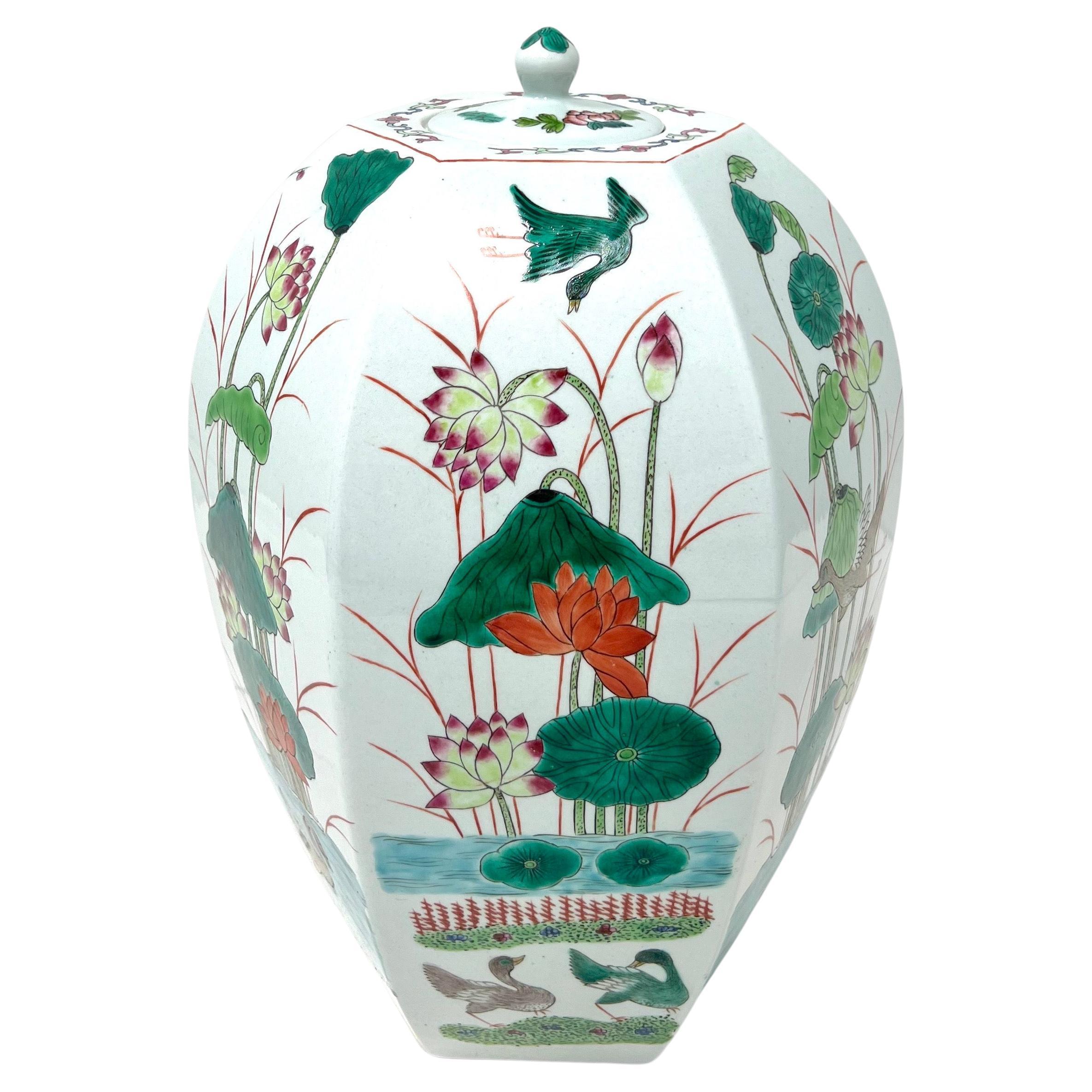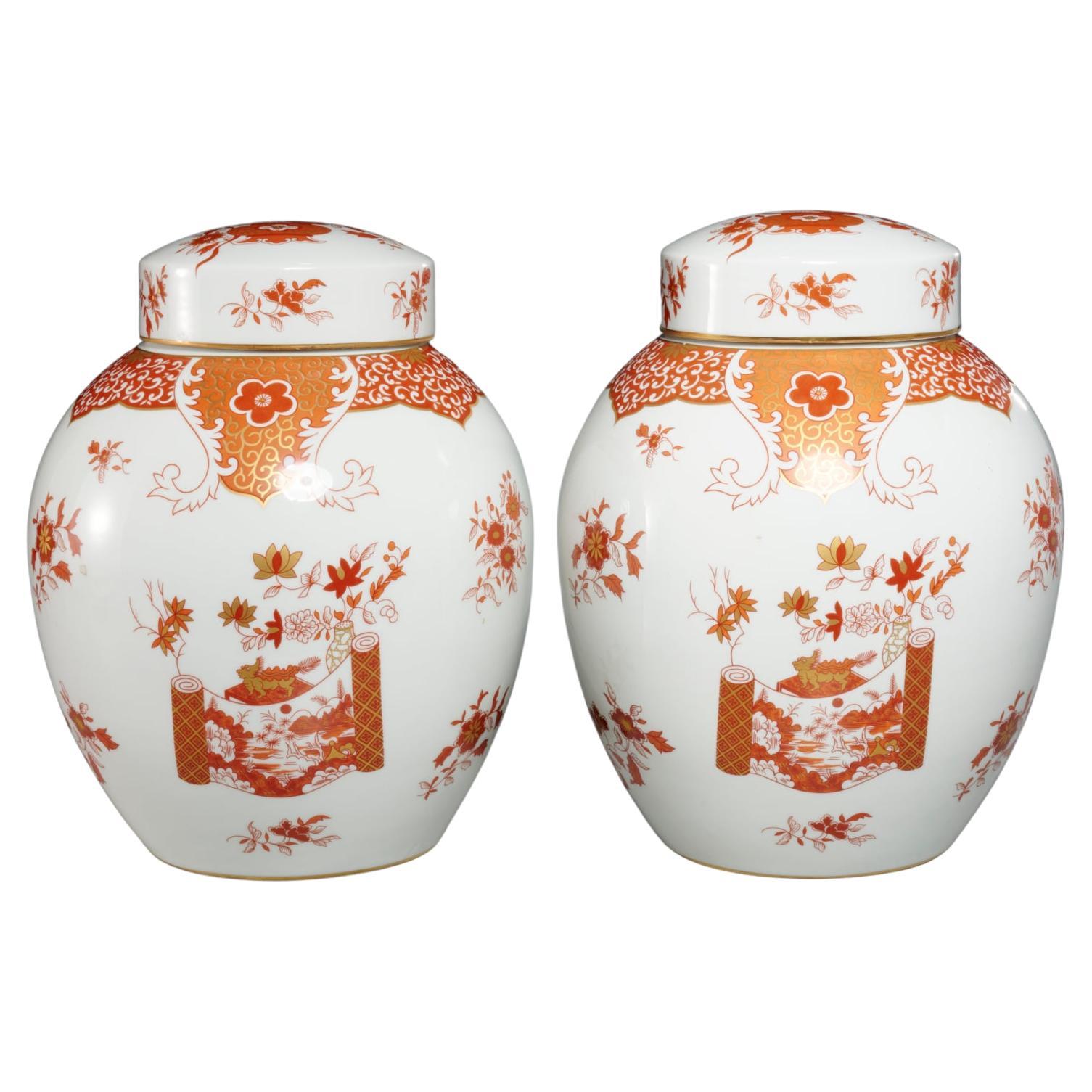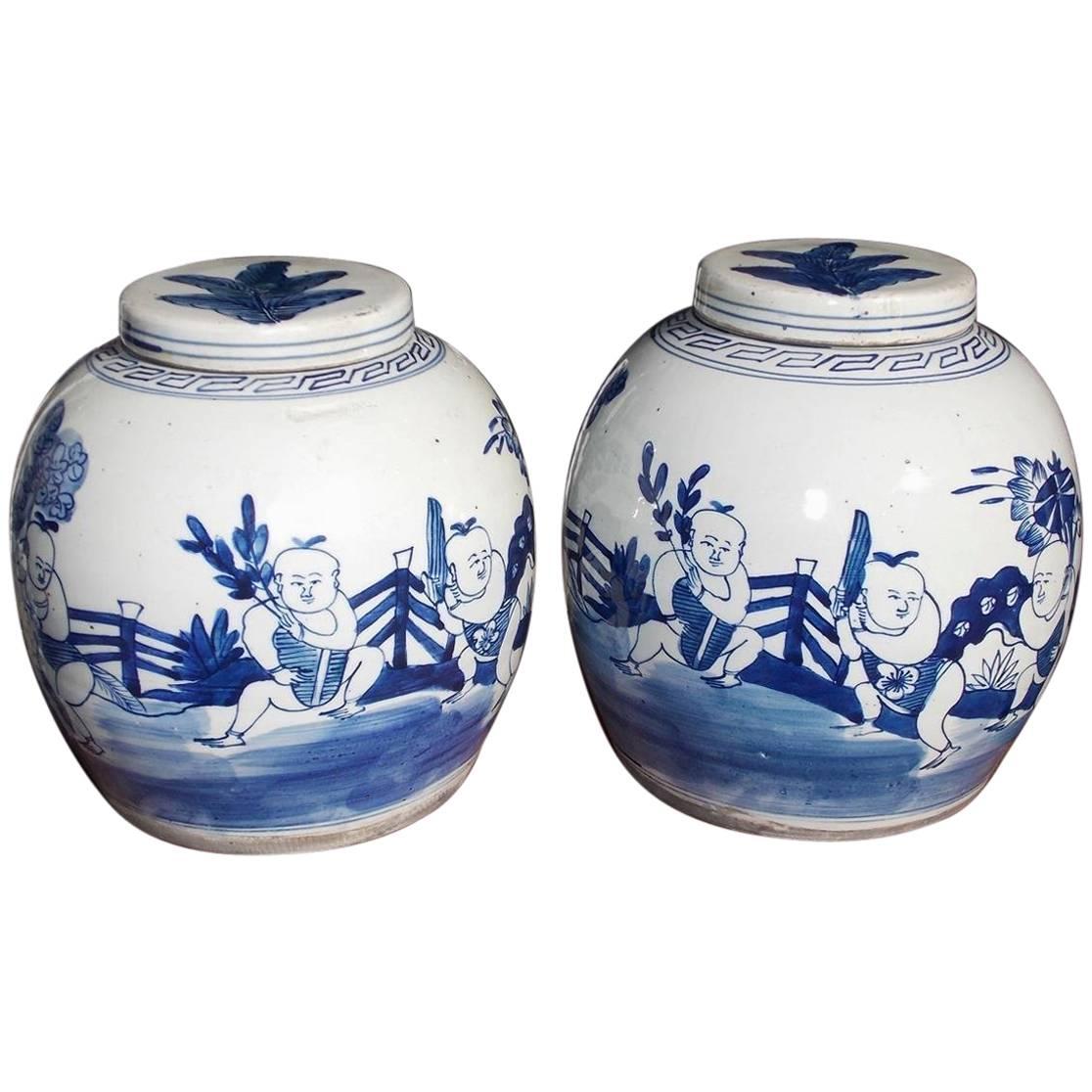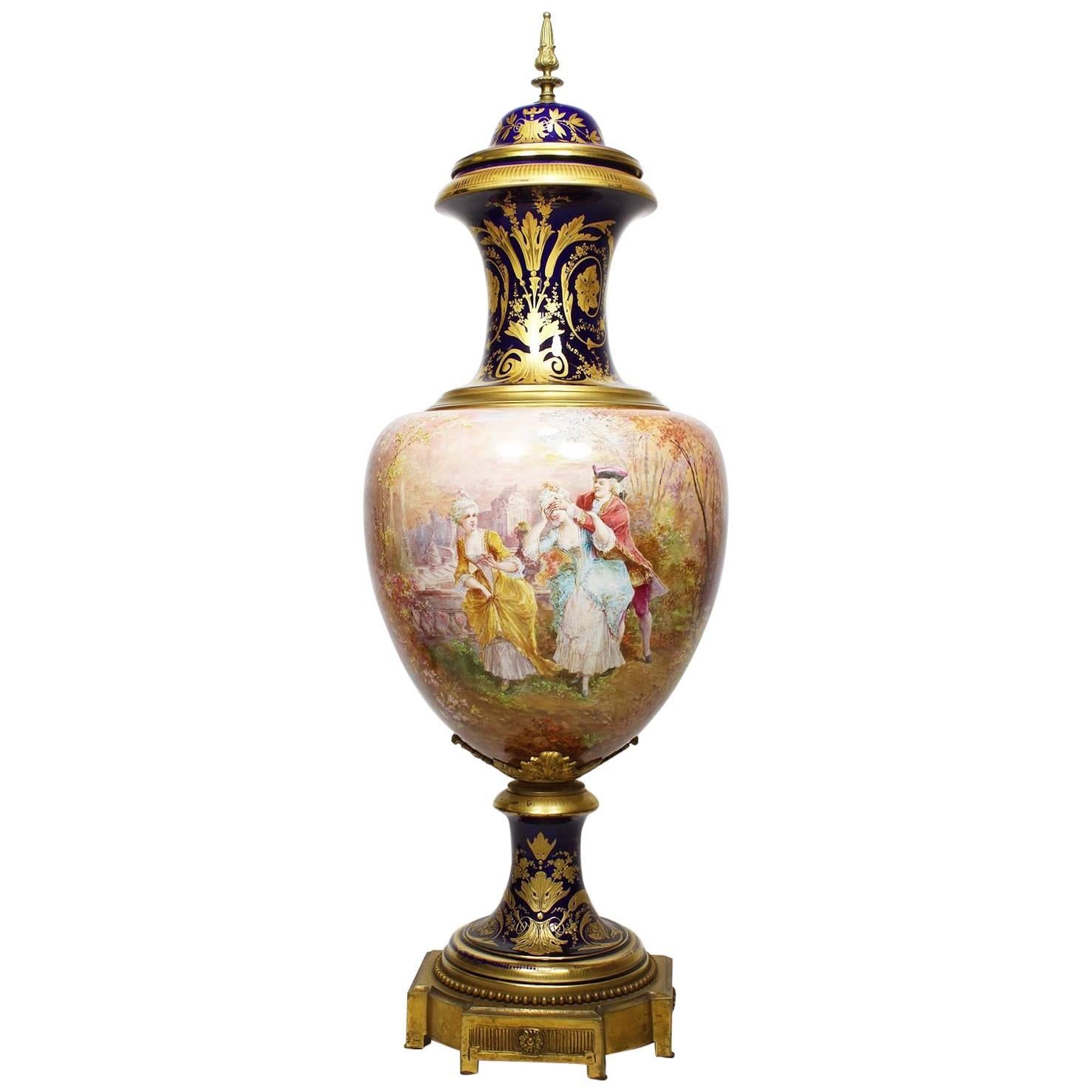Items Similar to Mid Century Hertel Jacob German Porcelain Ginger Jar, Signed Fuchs-Nadler
Want more images or videos?
Request additional images or videos from the seller
1 of 12
Mid Century Hertel Jacob German Porcelain Ginger Jar, Signed Fuchs-Nadler
About the Item
A lovely mid-century Bavarian porcelain ginger jar with gold trim and gilt details by Hertel-Jacob Porzellan (German, 1906-1979). This large ginger jar is ornately decorated with a highly detailed romantic figurative landscape scene, in which three men depicted in gold enjoy an opulent picnic of wine, meat, and fruit under a tree, in front of a large medieval castle complete with a canon and canon balls. A gold leaf motif decorates the backside of the piece. The signature "Fuchs-Nadler" can be found within the picnic scene, underneath the tray of food and wine.
Stamped on bottom with mark "Hertel-Jacob Porzelan / Bavaria Germany", and the serial number 1266.
Measures 14"H x 7"D.
**Please note: The top of the lid has been re-attached and a hairline crack in the gold is visible (see photos).
Hertel-Jacob Porzelan History:
Porzellfabrik Jacob, Schödl & Co. (1906 until 1912)
The factory was founded in 1906 by the industrial Jacob together with his financial partner Schödl and its product range during the first years included giftware items, vases, storage canisters as well as tea and coffee sets; around 1908 the first full dinner sets were produced. After the initial success Schödl more and more retired from business leaving Jacob in charge who soon started looking for a more reliable partner as he could not organize and go through with the planned modernization and expansion of the factory next to dealing with the normal daily business. Jacob found this better partner in Mr. Hertel who instantly agreed to take over part of the work load; each of the two then had their own areas of specialization and the business was restructured and renamed, resulting in the company that later became famous.
Porzellfabrik Hertel, Jacob & Co. G.m.b.H. (1913 until 1979)
As the moderization and expansion had already started around 1910, it had already lead to smaller results; one of them was that the company by 1913 already employed 250 workers. After the second step however, and during the following partial automation process, the number of employees dropped to 200 around the year 1930 even if the number of items made for export had constantly increased. The factory remained relatively unharmed during WWII and in the year 1949 it already employed 175 workers that mainly produced tea and coffee sets as well as complete dinner sets, even if the decorations themselves did not reach their pre-war standard.
Even if the following years at first seemed successful, the company relied too much on its conservative designs and fell behind other companies that early enough invested in new molds and decorations. In 1968 the factory was taken over by the Melitta company, a business that was based around the invention of paper filters for brewing coffee and which also produced porcelain filter cones. What at first seemed a good idea soon lead to complications in the Melitta group; the new era of coffee machines and the resulting change in demand saw factory decline rapidly; it was therefore decided that the core company of Melitta should concentrate on filter production.
As Melitta itself still needed filter cones and branded coffee/tea sets, these were at first still made in the former porcelain factory, but more and more orders went to other companies that not only were able to produce the items cheaper but also employed their own modern designers. Shortly before 1980 the former factory of Hertel, Jacob & Co. was finally closed.
- Dimensions:Height: 14 in (35.56 cm)Diameter: 7 in (17.78 cm)
- Style:Biedermeier (In the Style Of)
- Materials and Techniques:
- Place of Origin:
- Period:
- Date of Manufacture:circa 1960s
- Condition:Repaired: The top of the lid has been re-attached and a hairline crack in the gold is visible (see photos). Repair made by our in-house conservator. Gold will be painted over at the seam. Wear consistent with age and use. Minor structural damages.
- Seller Location:Soquel, CA
- Reference Number:
About the Seller
5.0
Gold Seller
These expertly vetted sellers are highly rated and consistently exceed customer expectations.
Established in 1986
1stDibs seller since 2015
166 sales on 1stDibs
Typical response time: <1 hour
- ShippingRetrieving quote...Ships From: Soquel, CA
- Return PolicyA return for this item may be initiated within 14 days of delivery.
More From This SellerView All
- Pair of Austrian Royal Vienna Porcelain Encrusted Floral VasesBy Royal Vienna PorcelainLocated in Soquel, CAPair of exquisite 19th century Royal Vienna porcelain vases. A fine example of the Neo-Classical Austrian style, these vases are decorated with an ornate garden floral motif. Encrusted with sculptural bunches of pink and yellow roses, and painted with tiny bees, butterflies, and gold accents. The Royal Vienna mark (Bindenschild, or shield) appears on the base of each vase in blue. Each vase measures 7"H x 4"W x 4"D. History of The Royal Vienna Porcelain Factory: The Royal Vienna Porcelain factory was founded in 1717 by Claudius Innocentius Du Paquier...Category
Antique 19th Century Austrian Neoclassical Vases
MaterialsPorcelain
- 19th Century Limoges French Painted Porcelain PitcherBy Delinieres & Co. 1Located in Soquel, CA19th Century Limoges French Painted Porcelain Pitcher Rare and prized, American Amateur painting on French Limoges pitcher, circa 1897. Dimensions, 1...Category
Antique 19th Century French Aesthetic Movement Vases
MaterialsPorcelain, Paint
- Mid Century Pink Murano Glass Bud VaseLocated in Soquel, CABeautiful vintage Murano, hand blown, Italian glass vase. This thick Murano vase depicts a very elegant solid blush pink top with a clear glass layer over the pink and a clear base. ...Category
Vintage 1960s Italian Art Deco Vases
MaterialsGlass, Art Glass, Blown Glass, Murano Glass
- Vintage Mid-Century Orrefors Crystal Decanter with StopperBy OrreforsLocated in Soquel, CAElegant Mid-Century Modern vintage crystal decanter with stopper by Orrefors (Swedish, founded 1898), c. 1960's. Engraved signature to base Orrefors HM 2498 - this particular style was by Edvard Hall. Includes original red Orrefors Sweden sticker with logo. "Orrefors HM 2498" etched into base. Measures 11.5" H x 3" W x 3" D. Orrefors Glassworks was founded in 1898 on the same site where ironworks operations had been run since 1726. In the same year that the glassworks was founded, a hot shop was built for making technical, medical and household glass and stemware to make use of waste wood and labour. Glass now replaced the less profitable ironworks operations. In 1913, Consul Johan Ekman from Gothenburg became the new owner of Orrefors Glassworks. He appointed Albert Ahlin as manager of the glassworks and this marked the start of a new era. In 1914, Orrefors started manufacturing crystal products, and as well as cut crystal according to purchased patterns and samples, Orrefors made art glass using the overlay technique with etched decoration. The new management quickly saw that artists were needed in the business, so Simon Gate was employed in 1916 and was joined by Edward Hald a year later. That same year, Gate and Hald made their first tentative attempts at figure engraving. They also experimented with the new innovative graal (grail) glass technique that was developed at Orrefors by the master glassblower Knut Bergqvist. The major successes were achieved a few years later at the Gothenburg Exhibition in 1923, and in particular at the Paris Exhibition in 1925. The thin engraved glass was admired by the surrounding world, and both Orrefors and the artists themselves were awarded the Grand Prix. The successes of Simon Gate and Edward Hald in Paris in 1925 constituted the start of the long Orrefors tradition of creative design closely combined with genuine and innovative craftsmanship. Since then, new designers and skilled glassmakers have continued in the spirit of Gate and Hald. Vicke Lindstrand and Edvin Öhrström with the new glass technique called Ariel in the 1930s. Sven Palmqvist with Kraka and Ravenna in the 1940s. And in the 1950s with Fuga, which, along with Nils Landberg’s slender tulip-shaped glass “Tulpan” and Ingeborg Lundin’s apple-shaped vase “Äpplet”, are now seen as symbols of the renaissance of Swedish design. The 1960s are associated with Gunnar Cyrén’s Pop glass, and in the 1970s, Eva Englund, Olle Alberius, Lars Hellsten and Jan Johansson as well as Cyrén worked at the glassworks. Since the 1980s, designers such as Anne Nilsson, Erika Lagerbielke, Helen Krantz, Matz Borgström, Per B Sundberg, Martti Rytkönen, Lena Bergström, Ingegerd Råman, Malin Lindahl and Efva Attling...Category
Mid-20th Century Swedish Mid-Century Modern Bottles
MaterialsCrystal
- Small Mid-Century Modern Red Murano Glass Bud VaseLocated in Soquel, CASmall Mid-Century Modern Red Murano Glass Bud Vase Bright translucent red hand blown Murano glass bud vase, with four large ridged details. One ...Category
Mid-20th Century Italian Mid-Century Modern Vases
MaterialsGlass, Blown Glass, Art Glass
- Modern Cyan Blue & Yellow Blown Glass Vase, Signed M. SaullLocated in Soquel, CAModern Cyan Blue & Yellow Blown Glass Vase, Signed M. Saull Vibrant cyan blue glass vase with yellow and black accents reminiscent of agate. V...Category
Late 20th Century American Organic Modern Vases
MaterialsGlass, Blown Glass, Art Glass
You May Also Like
- Mid 20th Century Porcelain Hand Painted Asian Ginger JarLocated in Charlotte, NCAn Asian Chinoiserie style ginger jar with lid, unbranded. Fine porcelain body in a hexagon shape, hand painted with a multi-color Chinoiserie scene and a tiny round handled lid. Lik...Category
Mid-20th Century Chinese Chinoiserie Jars
MaterialsPorcelain, Paint
- Mid 20th C. Kutani Style French Porcelain Lidded Ginger Jars - A PairBy Porcelaine de ParisLocated in Morristown, NJ20th c., a pair of Japanese Kutani style porcelain lidded jars, stamped on Porcelaine de Paris underside of foot. The mark indicates the piece was produced in the 1970's. The jars are decorated in deep orange, tangerine and gold motifs on a white background. On one side, both jars have matching decoration depicting a scroll showing a pastoral scene. On the other side, each jar has a seperate floral depiction; one including bamboo. Both are highly decorative. Founded 1773 by Jean-Baptiste Locre, Porcelaine de Paris, was one of the first manufactures to use the Chinese secret of porcelain. It immediately aimed for the luxury trade, selling to the Royal Courts of Europe. After surviving the French Revolution, Porcelaine de Paris steadily produced tableware as well as purely decorative pieces, receiving orders from all over Europe. Productivity was astonishing, creating one new model every day over 30 years! Around 1830, Jean-Marx Clauss, a German-born potter bought a building at Rue de la Pierre-Levee, where he took over Locre's activity. M. Achille Bloch...Category
Vintage 1970s French Japonisme Jars
MaterialsGold
- Mid 20th Century Chinese Ginger Jar with Dog on LidLocated in Charlotte, NCAn Asian chinoiserie style ginger jar with lid, unbranded. fine porcelain body, hand painted with a multi-color chinoiserie scene and a tiny gold painted dog to form the handle for l...Category
Mid-20th Century Chinese Chinoiserie Jars
MaterialsPorcelain, Paint
- Pair of Chinese Porcelain Glazed Figural Ginger Jars with Lids, 20th CenturyLocated in Hollywood, SCPair of Chinese blue and white porcelain glazed decorative figural and floral ginger jars with the original removable lids, 20th century.Category
20th Century Chinese Chinese Export Porcelain
MaterialsPorcelain, Paint
- Fine French 19th Century Napoleon III Sèvres Style Porcelain Urn Signed Ch FuchsBy Manufacture Nationale de SèvresLocated in Los Angeles, CAA fine French 19th century Napoleon III Sèvres style porcelain and ormolu-mounted covered urn, the 360 degree painted urn centered with an 18th century romantic scene of two ladies a...Category
Antique 19th Century French Louis XV Porcelain
MaterialsOrmolu
- Rare 1950s Hertel Jacob Porcelain Bavaria Germany Modernist Pair of VasesBy Hertel-Jacob PorzellanLocated in Palm Springs, CAA very rare pair of porcelain vases from the house of Hertel-Jacob Porzellan, Bavaria Germany. They measure 8" by 5" and 7.5" by 4", both are signed Hertel-Jacob Porzellan, Bavaria, ...Category
Vintage 1950s German Mid-Century Modern Vases
MaterialsPorcelain
Recently Viewed
View AllMore Ways To Browse
Vintage German Sign
Vintage German Signs
Midcentury Tea
Vintage Tea And Coffee
Midcentury Organizer
Jacob Gold
Vintage Food Signs
Vintage Food Sign
Porcelain Jars With Lids
H Jacob
Large Jar Lid
Large Lidded Jar
Mid Century Organizer
Full Kitchens Mid Century
Vintage Charge Plate
Large Jar With Lid
Large Jars With Lids
Vintage 1960s Food





